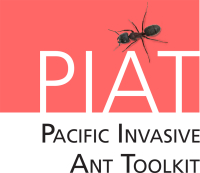African big-headed ant
|
harms crops |
harms wildlife |
lives on ground |
night active |
day active |
different sizes |
Scientific name: Pheidole megacephala
Other common name: coastal brown ant
Size: minor workers 2 mm, major workers (soldiers) 3-4 mm
Colour: light ginger-brown, dark brown shiny abdomen

African big-headed ants scavenging on a dead bird (© Meghan Cooling) |

Close-up view of minors and majors (with the giant heads) of the African big-headed ant (© Western Australian Agriculture Authority, 2013–2016) |
General description: workers come in two different sizes and shapes (dimorphic): minors are small with normal sized heads, while majors have extremely large heads that gives these ants their name. Majors are not seen as commonly as minors, as they only make up 1% of the colony. African big-headed ants’ nests and foraging trails are characterized by small mounds or tubes of excavated soil.
|
African big-headed ant minors tending a major (© Alex Wild) |
African big-headed ant workers with their much larger queen (© Alex Wild) |
Habitat and nesting: the African big headed ant may be found in a wide variety of nest sites. Nests may be found in rotten logs, under stones, beneath concrete pavers or in the litter around trees and in the crevices of their bark. While the ant typically nests outside, it has been known to nest in the wall cavities and ceilings of buildings.
Rate of spread: 15 m/year in Northern Australia.
Distribution: see our invasive ant distributions page for the worldwide distribution of the African big-headed ant.
Reproduction: new colonies are formed by budding, sometimes by a single queen.
Development: eggs take 13-32 days to hatch into larvae. Larvae develop for 23-29 days before becoming pupae. The pupae develop for 10-25 days, after which adults emerge. Temperature has a strong influence on development time. The warmer it is, the faster the brood (eggs, larvae, pupae) develops.
African big-headed ants in Hawaii foraging on peanut butter. Note the major worker with the giant head, Vimeo video (© Eli Sarnat, Creative Commons Attribution Share Alike CC BY-SA Licence) |
African big-headed ants nesting in soil in Hawaii, Vimeo video (© Eli Sarnat, Creative Commons Attribution, Share Alike CC BY-SA Licence) |
|
African big-headed ant foraging tubes on palm (© R.H. Scheffrahn, University of Florida) |
Mounds of soil excavated by African big-headed ants digging around a water pipe (© R.H. Scheffrahn, University of Florida) |
For detailed descriptions and identification of African big-headed ants please see:
PIAkey: Pheidole megacephala (see diagnostic characters tab)
Impacts of the African big-headed ant
SocialThe African big-headed ant is a major household pest, nesting in walls and foraging in kitchens and bathrooms. It has powerful jaws and has been known to chew on telephone cabling and electrical wires, causing serious damage. They can also easily chew through sealed plastic food packages, ruining food. AgriculturalThis ant is an important agricultural pest on many crops, such as pineapple, sugarcane, bananas and coconuts. The ant causes the outbreak of pest species and plant diseases by tending sap-sucking insects. They also prey upon biocontrol agents and predators of these pests. In Hawaii, African big-headed ants damage agricultural equipment, such as irrigation drip tubes in sugarcane fields. EnvironmentalFew other invertebrate species can survive in areas infested with African big-headed ants. This can have serious consequences for other animals, like insect-eating birds, because they can no longer find food in these areas. African big-headed ants can kill and eat hatchling birds and baby sea-turtles. They are also known to injure or kill nesting seabirds. |
African big-headed ant minor workers tending aphids (© Alex Wild)
On left, African big-headed ants attacking a bonin petrel chick on Kure Atoll, Hawaii. The webbing on the chick’s feet is especially vulnerable (© Cynthia Vanderlip, Maui Invasive Species Committee (MISC) website). On right the ants are covering an adult petrel (© Sheldon Plentovich, MISC website) |
Management
If you are interested in getting rid of African big-headed ants, check out the treatment options for this species, or look at management programme case studies to see examples of other control programmes that target them.
Information sources
AntWiki website, African big-headed ant
CABI website, African big-headed ant
GISD database, African big-headed ant
Global Register of Introduced and Invasive Species (GRIIS)
Hoffmann, Andersen, Hill. 1999. Impact of an introduced ant on native rain forest invertebrates: Pheidole megacephala in monsoonal Australia. Oecologia 120: 595-604
Holway, Lach, Suarez, Tsutsui and Case. 2002. The causes and consequences of ant invasions. Annual Review of Ecology, Evolution, and Systematics 33: 181-233
Island Biodiversity and Invasive Species Database (IBIS)
Landcare Research Manaaki Whenua Ant Factsheet, African big-headed ant
Wetterer. 2007. Biology and impacts of Pacific island invasive species. 3. The African big-headed ant, Pheidole megacephala (Hymenoptera: Formicidae). Pacific Science 61(4): 437-456







